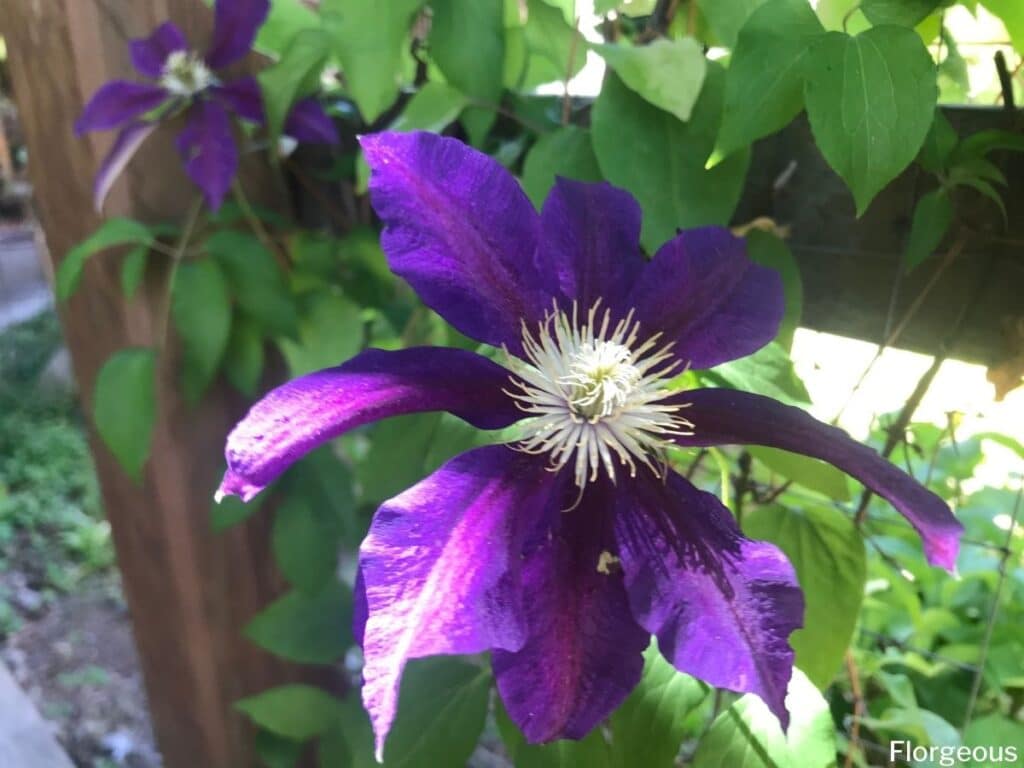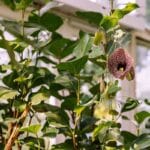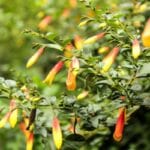Clematis vines are one of the highly utilized flowering vines in a landscape, making it the Queen of Vines. People love to see this vine’s flowers of different colors that vary depending on the type. Due to the vast selection of clematis vines, there is one that will tick the right boxes.
Read on to find the best type of clematis vine for your landscape.
Common Characteristics of Clematis Vines
The clematis vine has over 250 species and thousands of varieties sharing common characteristics. These clematis plants are known to be aggressively growing, low maintenance, evergreen, and Queen of the vines.
In the article How to Grow and Care for Clematis Vines, the different clematis groups were discussed to sort out the characteristics of varieties and species. Packed with knowledge from that, the information below will serve as a guide as to what type of clematis vine is perfect for a landscape theme.

Types of Clematis Vines Under Different Groups
GROUP 1: Early Flowering Clematis
Downy Clematis
This clematis vine species goes by the scientific name Clematis macropetala. This plant reaches up to 15 feet in height and shows off its flowers during April and May. As the main attraction, these bell shaped flowers are around 2 to 3 inches in diameter and are shaded lightly with blue or purple.
They prefer to be planted in cool and shaded areas. Some of the varieties of this clematis species produce pink, purple, or blue double flowers.
Anemone Clematis
C. montana is also known as Himalayan clematis and Mountain clematis. It is an aggressive grower that extends for 20 to 30 feet in height. Blooms are produced in clusters with 2 to 2.5 inches diameter for each pink or white flower.
If the color of this species’ flowers still needs some modification for the landscape theme, one of its famous varieties is the C. montana ‘rubens’. This variety produces more chic and soft-colored pastel pink flowers.
Alpine Clematis
C. alpina is a clematis vine species that produces fragrant flowers that are small, bell-shaped, drooping, and light purple to indigo. These clematis flowers flourish during April and May. Aside from its beautiful blooms, the clematis alpina can also grow for up to 8 feet.
Armand’s Clematis
C. armandii is the scientific name of the Armand’s clematis or evergreen clematis, an aggressive vine that loves to flower on old wood and could reach up to 30 feet in height.
During April and May, its 2-inch long white or red flowers are featured. Along with its attractive colors are its vanilla-like scent, which is stronger during warm weather and because the flowers are often clustered.
Rejuvenative pruning is the main maintenance activity for this vine to keep its vitality.
GROUP 2: Large-Flowered Clematis
C. lanuginosa ‘Candida’
This cultivar is a product of the cross between C. patens and C. lanuginosa. The combination of the genes from the said parentals resulted in single white flowers that extended up to 8 inches.
Each flower also has beautifully contrasting bright and long yellow stamens. Also, blooms are found growing on new and old stems.
Florida Clematis
C. florida is a clematis vine species that gives off large and interesting flowers. Each flower can extend for 5 to 7 inches across, with a lavish purple and green middle surrounded by creamy white sepals. This species is best grown in areas with hot climates.
‘Hagley Hybrid’
June to September are the best months to witness the blooms of the Hagley hybrid. It can extend to 8 feet tall with each flower 4 inches across. Moreover, each flower is pigmented with different shades of pink, from deep to pale pink.
‘Henryi’
One of the old reliable clematis hybrids is Henryi. It has a reputation for blooming for long periods during summer. Also, it produces huge white blooms and could grow as far as 12 feet tall.
‘Ernest Markham’
Ernest Markham is a hybrid that is suitable for beginners, since it is one of the easiest vines to grow but can still serve a good aesthetic. Its flowers vary its colors with different shades of red with good contrast with its bright yellow anthers.
‘Nelly Moser’
This clematis vine hybrid blooms twice a year, first in May then in September. During these months, flowers are pigmented with an old rose color on the petals with a bright red center and maroon anthers. It reaches as far as 10 feet tall but during flowering, avoid full sun exposure for the flowers. Its flowers are sensitive to extreme light exposure.
‘Jackmanii’
July to August is the time for Jackmanii to shine and showcase its 5-inch wide deep indigo flowers. It can also reach a height of up to 10 feet.
‘Marie Boisselot’
This hybrid thrives and extends to 12 feet and is a persistent vine. It showcases 8-inch wide lilac-pink flowers from June to September.
‘Toki’
This clematis hybrid loves to bloom from early spring up until early summer. It shows off its 6 to 8-inch white flowers with bright yellow anthers. After the first flowering, this vine will produce more flowers during the last weeks of summer to the first few weeks of fall.
‘Mrs. Cholmondeley’
May to October are the months when this hybrid takes the spotlight with its light purplish-blue 8-inch wide flowers. Also, this vine can reach as far as 20 feet tall.
‘Barbara Jackman’
This clematis vine is an old hybrid that has blue-violet petals with a striking red-violet crown and cream-colored stamens. Moreover, this plant can go up to 8 feet in height.
‘General Sikorski’
General Sikorski is the hybrid for those who love textured and large flowers. Its flowers extend up to 6 to 9 inches and the plant itself reaches as far as 10 feet in height.
‘Niobe’
This clematis vine shows off wider flowers, forming a cup-like shape. Its flowers are deep maroon to bright red with an accent of cream-colored stamens. Moreover, each flower can extend up to 6 inches across. This vine is not as aggressive as a grower like the other varieties.
‘Multi Blue’
From its name, this clematis vine hybrid bears double dark purple or blue flowers, which are showy during late spring and early fall. Also, this clematis vine extends up to 8 feet high.
GROUP 3: Late-Flowering Clematis
C. tangutica
Also known as the orange peel clematis, this species produces small blooms that are rounded. They also have a deep yellow-orange color, which makes them look like Chinese lanterns. As the plant progresses and continues to develop, hairy silver pods arise.
‘Rooguchi’
This clematis cultivar differs by having multiple stems that are not climbing. Given its stems’ characteristics, it extends up to 8 feet in height and 4 feet in width. Also, its blooms are drooping bell-shaped with a deep purple pigment.
C. viticella
Commonly known as the Italian clematis, this vine flourishes and blooms deep violet flowers from July to September. Also, it reaches up to 10 to 12 feet in height and could tolerate higher temperatures. This behavior is because it came from Western Asia and Southern Europe, wherein the temperature is warmer.
C. virginiana
The C. virginiana or woodbine is a clematis vine that is closely similar to the sweet autumn clematis. However, it is not an invasive species like its look-alike, but it has suckers making it easy for new plants to arise. Its growth habit may be a problem for those with limited space for planting. On the other hand, this clematis vine blooms from August to October, with its sweet-scented white flowers.
C. texensis
This clematis vine species is commonly known as the Texas clematis, scarlet clematis, scarlet leather flower. It is a native of Texas and can withstand hot summer days. Its leaves have a hint of blue, while its blooms’ colors range from red, yellow, purple, and orange.
Things to Remember in Choosing the Right Clematis Varieties
Remember to have a checklist of the plant characteristics that will fit perfectly in a landscape. Incorporate attributes such as colors, growth habits, and blooming seasons to search for the best fit. Also, include the plant in the landscape plan and maintenance schedule.
This planning and organizing are possible with the help of the knowledge acquired from knowing how to grow and care for clematis vines.
FAQs
What is the best clematis for beginners?
The best clematis for beginners is often considered to be Clematis ‘Nelly Moser’ or Clematis ‘Jackmanii’. These varieties are hardy, reliable, and easy to grow, making them ideal choices for novice gardeners.
What is the longest blooming clematis?
Clematis ‘Arabella’ is known for its long blooming period, producing an abundance of flowers from late spring to early autumn. This makes it one of the longest blooming clematis varieties available.
Which clematis blooms the most?
Clematis ‘Niobe’ is prized for its prolific flowering habit, producing numerous large, deep red flowers throughout the growing season. Its continuous blooming makes it one of the clematis varieties that blooms the most.
What is the strongest smelling clematis?
Clematis ‘Sweet Autumn’ is known for its strong, sweet fragrance, which intensifies in the evening. This variety produces clusters of small, white flowers with a delightful scent, making it a popular choice for adding fragrance to the garden.
What is the rarest clematis?
The rarest clematis varieties are often those that are newly introduced or highly sought after by collectors. Varieties like Clematis ‘Kirigamine’ or Clematis ‘H.F. Young’ may be considered rare due to limited availability or unique characteristics. Availability can vary depending on the region and nursery stock.
Up next: What to plant with clematis
References







